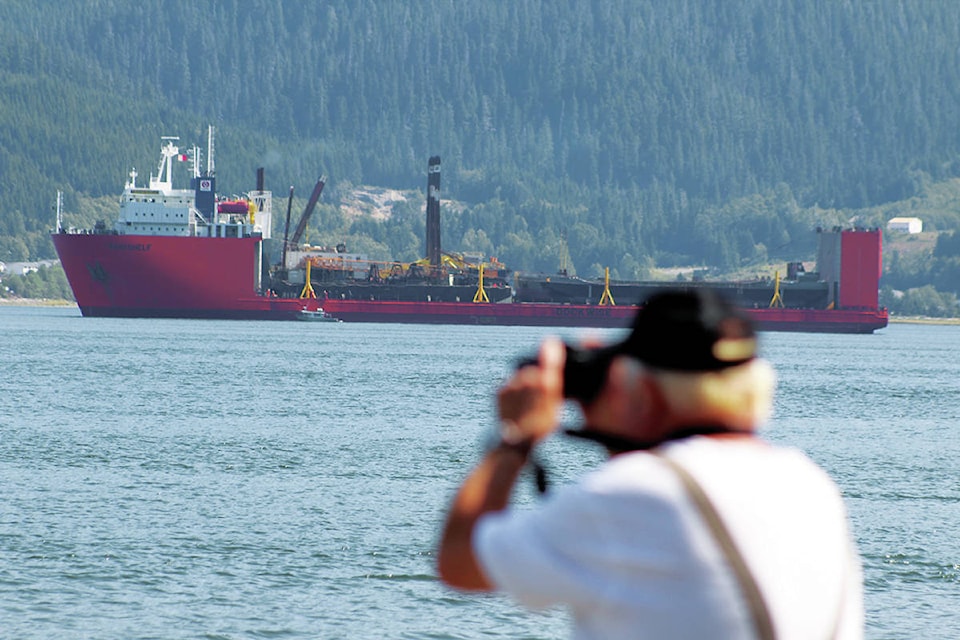The arrival of the carrier ship Transshelf marks the beginning of dredging of the Port of Kitimat in preparation for a potential positive Final Investment Decision for the LNG Canada project.
The Transshelf arrived in Kitimat on Sunday carrying a number of dredging vessels which were floated off its decks when the special carrier ship was partially submerged on Tuesday morning.
LNG Canada construction lead for marine works Sander Oerlemans said an estimated two million cubic metres of material will be dredged from the seabed on the industrial side of the port in the vicinity of the Rio Tinto and the former Methanex and Eurocan wharves.
Oerlemans, who joined the project on August 1, is responsible for the scope of the dredging and the wharf extensions.
The dredging, which is part of LNG Canada’s summer works, is necessary to deepen the port to allow the larger LNG ships to be able to dock in Kitimat.
The dredge material that will be brought to the surface will consist of four types of material - hazardous dredge material, two milder forms of contaminated materials called IL+ and IL- (IL is the abbreviation for Industrial Limit) and DAS (Dispose At Sea).
The hazardous dredge material will be brought ashore and stabilized, after which it will be disposed of offsite by the contractor, Dutch dredging firm Boskalis, at an approved facility.
Material brought up from the Rio Tinto dredging area will be disposed of onshore in a dredge disposal site (DDS) on Rio Tinto land. Material dredged from LNG Canada’s portion will be stabilized and transported off-site.
The IL- material, while meeting industrial use standards, cannot be disposed of at sea. The IL+ material cannot be used for industrial use and has to be disposed of in the DDS.
“There have been several monitoring campaigns of the dredge material. They have done sampling in the soil,” said Oerlemans. “While it’s not an exact science we have identified where the hazardous area is, where the IL+ lies, where the IL- is and what is clean.”
Oerlemans said his environmental team was able to identify petroleum remains in one of the areas where dredging will occur.
“To the best of my knowledge these are petroleum contents which are remainders from the production of the aluminium smelter which ended up in the soil, sometimes referred to as pitch which comes out of the aluminium process,” said Oerlemans.
“These are petroleum contents in relatively low volumes in the soil, typically 2 milligrams per kilogram.”
The IL- will be pumped into a berm where it will be stored for industrial land use.
The IL+ will be pumped into a berm which is sealed with a lining, preventing any of the material leaking into the soil.
The site also gets a capping layer which prevents any of the material going into the atmosphere.
“Be careful with the classification ‘hazardous material’.
“It is hazardous material because it exceeds certain limits, but it doesn’t mean that this is immediately toxic or dangerous for human beings,” said Oerlemans.
“It doesn’t mean if this material gets spilled that it would immediately be a danger to people.”
A stabilization plant will be built to deal with the IL+ material being brought up from the LNG Canada berth.
There the material will be mixed with cement which ensures the material is stable and can be disposed of safely.
He said during the dredging the team will monitor what contaminants are in the dredge material and at what levels.
“Several monitoring campaigns will be ongoing during the dredging to test soil samples for contaminants as the dredged material is brought ashore,” said Oerlemans.
He added that two million cubic metres of material is not an abnormal quantity of dredge material for a typical dredging scope for oil and gas developments.
LNG Canada director of external relations Susannah Pierce said the dredging and the salt marshes that will be built in Minette Bay to replace salt marsh and eelgrass habitat “will be a significant improvement over the conditions in place currently, and will far outweigh the disturbances dredging may create.”
Environmental monitoring
A number of surveys will be conducted, prior to dredging, testing the turbidity to establish a baseline which they will use to compare to the turbidity once dredging starts.
The environmental team will also conduct crab salvage and monitoring, setting traps in the work area to catch crabs and relocate them offshore.
Approximately 90 traps will be deployed on the seafloor in the vicinity of the LNG Canada dredge area and will remain in place for approximately 12 hours.
Oerlemans said the traps will then be brought to the surface and the crabs will be transported to the designated release site.
“This will be performed immediately prior to dredging.
We anticipate that once dredging begins, the presence of equipment and the temporary increase in suspended sediments in the water column will serve as a partial deterrent to the crabs to repopulate the area,” said Oerlemans.
Safety zones
Pierce said the dredging vessel operator generally requests safety zones around the vessel, normally between 300 to 500 metres away from the vessel.
However, with dredging activities taking place on the industrial side of the port in the vicinity of the Rio Tinto and the former Methanex and Eurocan wharves, the dredging won’t pose a risk to small commercial vessels, pleasure craft and fishing vessels operating out of MK Bay, Kitimaat Village or Minette Bay marinas that stay south and east of the former Eurocan wharf.
All dredge vessels will show navigation lights and shapes appropriate for the circumstances for indication to other mariners. All other vessel operators (except a vessel that is not under command), must give way and give the dredge vessel a wide berth to pass at a safe distance.
